



Ashton West End Primary Academy Presentation Policy Approved by the Curriculum and Standards Committee Date: 8 th July 2020 Review Date: July 2021
Mission Statement: ‘Today I am proud of my school, tomorrow my school will be proud of me.’ The purpose of this policy is to ensure that children at Ashton West End Primary Academy receive consistent messages about what is expected from them in relation to acceptable presentation of work. Standards are to be consistent no matter what the subject. Through high expectations of presentation, it is believed that the importance of the work that is produced will be enhanced, and help to raise self-esteem. Teacher expectation, persistence and consistency are the keys to improvements in children’s progress in both presentation and achievement. Principles: • Consistency of approach is key to raising standards of presentation • Standards of presentation will enhance the pride children have in work produced • The expectation is that all written work will receive the same consistent approach • Consistent teacher expectation of work will improve standards of work produced, not just in presentation, but in content as well Aims: • To ensure that quality work is produced by children at all ages and abilities • To enable children to have success, resulting in better self-esteem • To produce consistency of approach and standards, no matter the age group Monitoring and Evaluating: • The curriculum leads will collect samples of work, visit classrooms and talk to the children about their work regularly • Staff meetings will take place with a focus on presentation. Children’s books to be shared and staff to share the techniques they use to improve presentation within their classroom • Discussions will be encouraged with parents at events such as curriculum evenings, parents’ evenings and parent workshops • All staff will continually monitor their own practice and moderate across year groups during planning sessions Desirable Outcomes: • There will be an improvement in children’s learning • Children will become more self-confident and develop greater self esteem • Children will become more involved in their own learning and assessment and will develop a greater awareness of what is expected of them • Parents will develop a greater understanding of the school’s philosophy of the purposes of presentation and of its usefulness in terms of children’s achievement and progress • There will be consistency in presentation across year groups, between years and across the key stages
Guidelines: The following procedures for the presentation of children’s work to be implemented by all staff: Front covers: The cover of all books should be written by teachers and include: • Child’s name • Book title • Teacher’s name • Class – E.g Year 6 Miss Reynolds would be 6R • There should be no graffiti on/in any book Assessment sheets: • English and Maths books to have the child friendly assessment sheets stuck at the front of each book Layout within books: Date and learning objective: • Written work must start with the day, date and year which must be underlined with a ruler (In Maths, the date must be written in numerical form.) This is to be written on the right hand side. This can be typed and stuck on for key stage 1 children. • The Learning objective is written underneath the date with one line separating them both. E.g. Wednesday 14 th April 2020 LO: To use subordinating conjunctions accurately. • A line is then left after the learning objective. • A new page is started for each new lesson. Unless, for example, a child is continuing with a piece of writing, and then they can continue that same page with the short date written in the margin. Writing equipment: All children to write in pencil until they achieve a ‘P en License ’ . A pen license is achieved when: • All mistakes are crossed out in pencil with a ruler • Handwriting is neatly joined • Purple pen used for editing purposes (This needs to be evidence over at least 3 weeks of work to show consistency.) • The ‘Pen License’ is announced in assembly and the child will receive a certificate . • Where pupils have developed accurate letter formation and been awarded their Pen Licence, they should use a blue pen. Once awarded this pen, this should be used for all written work apart from Maths.
Mistakes within work: • One line, in pencil, should be drawn through any mistake with a ruler • Children must not use Tippex/liquid paper • Rubbers to be used with discretion but only on rare occasions, as rubbing out does not allow for the monitoring of progression Resources: • All resources to set high expectations • All resources are to be trimmed neatly. For example, if the resource is in a box, then the box to be cut around neatly • All resources to fit within the books, no sheets that are hanging out of the side • All work within the book to be stuck neatly and with care Marking: • Where lessons have been taught by a Supply Teacher this should be recorded as ‘Supply’ • All marking should follow the agreed Marking Policy
Recommend
More recommend